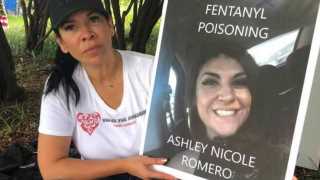The eggs sat on the counter and the potatoes waited in the pan for a late-night brunch as Ashley Romero died.
She took half a pill that appeared to be a prescription painkiller offered to her by her boyfriend. Romero had chronic pain her entire life from pancreatitis. When she was really hurting, she would sometimes take half a pill prescribed to her by her doctor.
This pill wasn’t prescribed, though. The fentanyl in the counterfeit tablet killed her in minutes. When the paramedics arrived at her Grand Junction home, both she and her boyfriend were unresponsive in her car. They revived her boyfriend with naloxone, but Romero died in the front seat on June 11, 2018.
She was 32 years old, a mother to an 8-year-old boy, a sister to three siblings, and Andrea Thomas‘ oldest daughter. The day after Romero’s death, her boyfriend died by suicide.
“I look at fentanyl as a drug of mass destruction,” Thomas said.
Romero is one of 1,275 Coloradans who died of overdoses involving fentanyl since 2018 as dealers have inserted the deadly synthetic painkiller into the state’s drug market. Fentanyl is particularly dangerous because tiny amounts can be fatal and the drug can be disguised as other substances and sold to unsuspecting customers, experts said. For those knowingly using the substance, it is particularly addictive, dangerous and difficult to treat.
“I very rarely see a patient coming in for heroin these days, it’s almost always fentanyl,” said Michelle Gaffaney, a physician’s assistant who works in Denver Health’s outpatient addiction treatment services.
In 2018, at least 102 Coloradans died after overdosing on fentanyl, according to data collected by the Colorado Department of Public Health and Environment. The following year, that number doubled — 222 people died. In 2020, the death toll more than doubled again and 540 Coloradans died.
And deaths are still rising in 2021. At least 381 Coloradans died of fentanyl overdoses in the first six months of the year — an average of 64 people a month, or two a day.
Every year, fentanyl deaths represent a larger and larger portion of all overdose deaths in the state. In 2018, fentanyl caused 10% of overdose deaths. In the first six months of 2021, 44% of all overdoses involved fentanyl.
Death “as a cost of business”
Fentanyl is a synthetic opioid used by doctors to treat severe pain. It is 100 times more potent than morphine and 2 milligrams of the substance can be lethal, according to the U.S. Drug Enforcement Administration. Fentanyl and other synthetic opioids are the primary drivers of the surging number of overdose deaths in the U.S., according to the Centers for Disease Control and Prevention. More than 93,000 Americans died of an overdose in 2020 and 60% of those deaths involved synthetic opioids, primarily fentanyl.
Illicit fentanyl started to appear in large quantities in Colorado in 2018, said Matt Kirsch, the acting U.S. attorney for the District of Colorado. Most fentanyl is in the form of pills, sometimes manufactured to look like prescription pain pills like oxycodone. But the substance comes in other forms, too, like bricks or rocks.
The majority of pills in Colorado are manufactured in Mexico from chemicals shipped there from China. The drug is then trafficked or mailed over the border, Kirsch said. Pills have varying levels of toxicity, even in the same batch, because pill presses operated by cartels in Mexico do not have the same quality control as manufacturers of prescription pills, he said.
Part of the reason for the explosion of fentanyl is that it is so much cheaper to produce than other drugs, Kirsch said. It is completely synthetic and doesn’t require agriculture like heroin, which needs fields of poppies. It’s easier and more profitable for dealers and manufacturers to sell fentanyl that looks like oxycodone than for them to sell oxycodone, even if it poses a deadly threat to their customer base.
“As despicable as it may be, I think it would be at least a logical conclusion for significant dealers of drugs to treat the deaths of some of their customers as a cost of business,” Kirsch said.
Fentanyl is different than many drugs because people using it often don’t know what they are consuming, Kirsch said. They thought they were buying heroin or oxycodone, but instead bought fentanyl. It’s like a fraud case grafted onto a drug case, he said.
“Most of the time the buyers aren’t willing buyers, they’re not buying what they think they’re buying,” he said.
Gaffaney, the Denver Health physician’s assistant, said she started to see an increase of people seeking treatment for addiction to fentanyl last summer. Now, about half of those seeking treatment for addiction at her facility use fentanyl pills. The drug’s potency makes it harder for medical staff to transition users to suboxone, a medication used to treat opioid addiction.
“Fentanyl is a more potent synthetic opioid, so often when our patients are exclusively using fentanyl they have more severe withdrawal symptoms, they’re coming in sicker,” she said.
The potency of fentanyl also means that it often takes multiple doses of naloxone to reverse an overdose. Naloxone, also known as Narcan, is a medicine that reverses opioid overdoses and restores breathing.
“There’s just this extra worry about our patients that might be using fentanyl because the risk is so high,” Gaffaney said. “We’ve lost patients to fentanyl this year.”
Colorado law enforcement agencies have made several seizures of large quantities of fentanyl. Investigators with the North Metro Drug Task Force in July intercepted a shipment of more than 40,000 pills containing fentanyl, three pounds of heroin and nine pounds of meth. Law enforcement officials in the Vail area have found several pounds of fentanyl pills while making traffic stops on Interstate 70. Denver police in 2019 found a kilogram of fentanyl, in brick and pill form, while serving a search warrant on a house. The brick at first appeared to be black tar heroin and the pills looked like oxycodone, but testing revealed they were fentanyl.
According to the DEA, a quarter of seized pills tested for fentanyl contain a lethal dose.
“Nobody should experience that”
Federal prosecutors have charged at least four people with the distribution of fentanyl causing death, including the man who brought the pill to Colorado that killed Romero.
A jury in April convicted that man, Bruce Holder, of distribution resulting in the 2017 death of Carbondale resident Jonathan Ellington among other charges. Holder was indicted on charges connected to Romero’s death, but prosecutors ultimately decided not to pursue those charges, her mother said.
Holder regularly drove to Mexico in 2017 and 2018 and picked up tens of thousands of fentanyl pills manufactured to look like oxycodone, according to investigators. He then brought them to Grand Junction, where he and some members of his family distributed them.
Since her daughter’s death, Thomas has worked to bring awareness about the danger of fentanyl. She previously owned a boutique and now works in her family’s drilling services company while running her nonprofit organization Voices for Awareness and raising Romero’s son, Daniel.
“I figured, if I didn’t know about fentanyl — and I’ve been in my kids’ business forever — many other parents probably don’t know,” she said.
Thomas remembers driving up to her mother’s house with her sons the day she learned Ashley died and the radiant smile her mother gave when she saw her family visiting. She remembers how that smiled turned to despair when her mother learned her eldest grandchild was dead. Thomas remembers watching her youngest daughter drop to her knees in the front yard, screaming, when she learned her sister was gone. She remembers telling her 8-year-old grandson that his mom was dead and that he would never see her again.
“And that’s why we do what we do, because nobody should experience that,” Thomas said. “It’s forever life-changing. I’m one of the lucky ones that can still get out of bed. I don’t have a choice. I have a family. I have this grandson who was the light of our lives.
“It might not be affecting you now. I pray that it doesn’t affect you. But it can. It affects the unsuspecting daily.”
Source: Read Full Article



